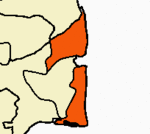| Uthrapathiswaraswamy Temple | |
|---|---|
 Central shrine | |
| Religion | |
| Affiliation | Hinduism |
| District | Nagapattinam |
| Deity | Shiva, Ganesha |
| Location | |
| Location | Thiruchengattankudi |
| State | Tamil Nadu |
| Country | India |
 | |
| Geographic coordinates | 10°51′48″N79°43′20″E / 10.86333°N 79.72222°E |
| Architecture | |
| Type | Dravidian architecture |
Uthrapathiswaraswamy Temple is a Hindu temple in Tiruchenkattankudi in Nagapattinam district in the Tamil Nadu state of India. Though it is dedicated to the Hindu god Shiva, it is more famous for its Ganesha (Ganapati) icons. [1] The main Ganesha shrine depicts him with a human head, instead of the elephant head he is usually depicted with. [1] Vatapi Ganapati, the other Ganesha icon, was installed in a smaller shrine at a later date.


